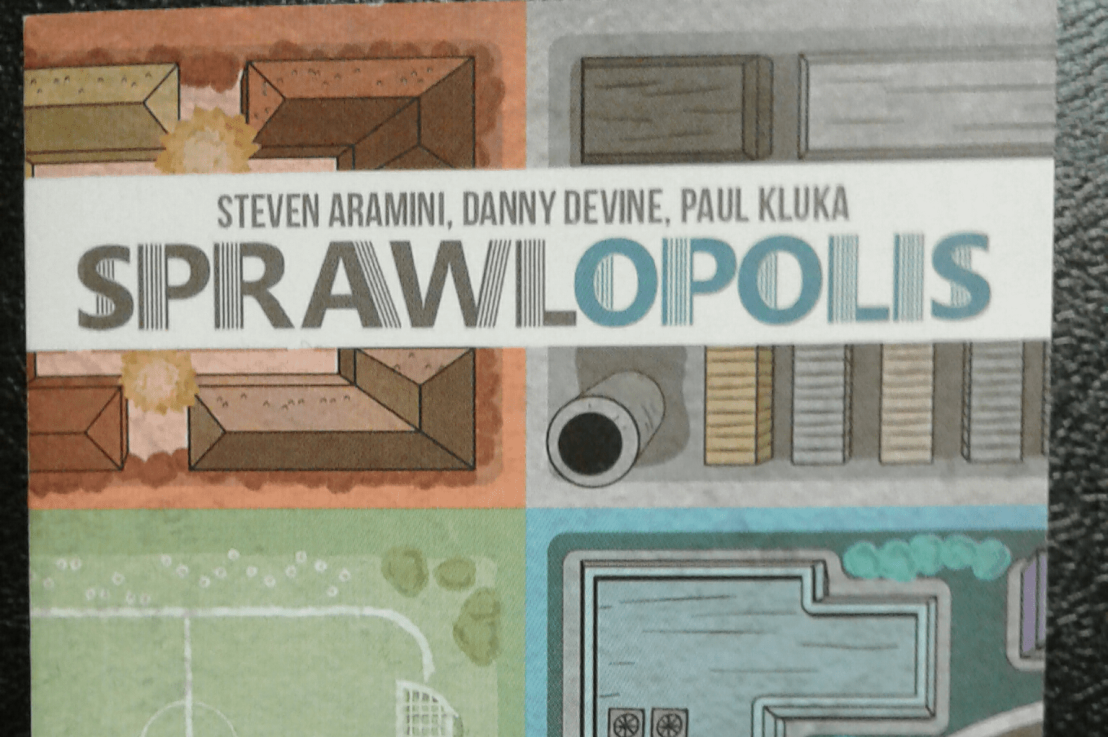A month or two ago, I reviewed a game called Stew. Stew is a brilliant little game that combines bluffing, deduction and press your luck and is brought to us by the wonderful publisher Button Shy. Button Shy is a game company that specializes in making hand crafted games that are small enough to fit in literal wallets. I own five of their games from their vast library and while Stew is my favorite of those, there is a very close second. And that game is Sprawlopolis.
Sprawlopolis is a cooperative tile/card laying game where you and your teammates are building a city together. The game, like almost every Button Shy game, is comprised of just 18 cards. Those cards are double sided, with one side containing scoring objectives and the other side being the actual city cards. Those city cards contain each of the four districts in the game (residential, commercial, industrial and parks) as well as a combination of streets snaking through in various directions. The game begins by setting aside three of those 18 cards and putting them scoring objective up. The prompt has a rule for scoring (such as 2 points for every Residential district adjacent to two Industrial districts, to pick an easy example) and a number. You add the numbers of the three cards together and that makes the final score you need to beat for that game. Then, after shuffling the rest of the cards, you and your other budding civic engineers try to make a city that doesn’t completely suck.
(Psst…chances are, it will suck. This game is hard.)
The game plays like many tile laying games, where you simply place cards adjacent to other cards to form a continually growing landscape. But! There is a twist. In this game, you can actually cover parts of already placed cards, even the entire damn thing. This opens things up considerably as you can try to overlap parts that are disadvantageous to your scoring while improving other parts of the city to improve said score. It’s like this game’s version of gentrification, only with much less of the sociological and moral ramifications that usually come with that.
It also leads to some very interestingly shaped cities. The first game I ever won of this, our city ended up looking like a duck.

The amazing thing about Sprawlopolis is that despite it being a mere 18 cards, the game gives you a lot to think about. You’re not just trying to score based on what the objectives have given you, but you also score based on how big certain blocks in your city are. The biggest continuous area of each district type gets gets one point per block in it. For example, if the biggest area of parks in your city is five blocks big, you get five points for your parks district. This extra scoring mechanism means that even as you’re focusing on the scoring objectives dealt at the beginning, you also have to keep in mind that you want to build up at least one big area of each of the district types. Focusing strictly on the objectives and ignoring the district scoring will rarely result in a win, but the rub is that often times the objectives don’t jive with making large masses of single districts. This creates a great decision space where you’ll be agonizing over how to maximize your overall score. It’s a balancing act akin to walking a tightrope while juggling Molotov cocktails. Also, there are puppies below you as you do so. Do you want to burn a bunch of puppies, you psychopath? Didn’t think so.
There is one more bit of scoring in the game, making it the thick syrup on this stack of scoring pancakes. The streets department of Sprawlopolis must be very lazy and cranky, because for each road in your city you lose one point. Joining together roads to make them longer and therefore less present in your city is the best way to minimize this damage. The worst thing you can do is to have lots of tiny little roads twisting and turning around your city, leading to nowhere like it’s an MC Escher fever dream. But again, trying to build long, continuous roads doesn’t always work with the city you’re trying to build for the objectives. Maybe there’s a great play you can make that will score you some extra points from the objectives but you notice that it will open up two new roads or even break apart a long connected road you had worked so hard on keeping together. As I said, it’s a balancing act and it packs so many great hair pulling moments in what is just a 10-15 minute card game.
When you deal with a microgame like this, one of the biggest concerns is its shelf life. As in, how many times can you actually play this thing before you realize it’s a much more shallow, and repetitive experience than you first thought? No disrespect to microgames, I love them, but it’s definitely a prevalent problem in a genre that is built around incredibly simple rulesets and low numbers of cards/components.
(I’m looking at you Coup and Love Letter.)
I’m happy to report that, maybe more than any other microgame I’ve played, this is not an issue with Sprawlopolis. One of the big reasons why is the different scoring objectives. Not only do the scoring objectives all feel different and varied, but you’re using a different, random combination each time. This, along with the fact that the city cards are all shuffled and come out randomly as well, means that every game of Sprawlopolis is going to feel unique and fresh. Sure, you may run into a couple games where two of the three scoring objectives have been paired together before, but it’s rare enough that it rarely feels stale. I mean, just do the math. With 18 scoring objectives, and a combination of 3 every time you play that’s like…uhh…umm…a LOT of combinations. Yeah, let’s go with that, ‘a lot’.
This also translates into wildly different looking cities every time you play. One of my favorite things about Carcassonne, perhaps the most popular tile laying game in the hobby, is that no matter how many times I’ve played it, the landscape me and my opponents had created always looked different game to game. That is very much the case with Sprawlopolis. I mean, I already showed you that damn duck. Depending on how the scoring objectives shape out, you can end up with smaller more compact cities, larger more sprawling (hey, that sounds familiar) cities or just some downright weird looking ones.

The last thing I’ll rave about is this game’s solo mode. I have been getting into solo gaming a lot over the past year (probably has to do with that whole ‘no social life’ thing I’ve got gotten on) and Sprawlopolis is easily one of the three best solo experiences I’ve ever played. The gameplay is completely unaffected. The only difference is you just simply keep a hand of three cards at all times since there are no other players to pass cards to. Which is completely fine, as it removes the one fiddly thing about the game anyway (in the multiplayer game you play, pass, then draw one card for a future turn, which for whatever reason has always felt clunky to me). This means the solo experience is just as enjoyable as playing the multiplayer game, something a solitaire game should ALWAYS strive for. In fact, in some ways it’s better, because playing solo means you don’t have to deal with your friends passive aggressively sighing at your placement of a card because you missed something obvious. It’s lack of a long time commitment makes Sprawlopolis the perfect bite sized solo game as well, meaning it’s super easy for me to pull out and kill 15 minutes with. All in all, if you are an avid solo gamer, Sprawlopolis is as good as it gets.
I really don’t have much in the way to criticize with Sprawlopolis. It’s variety game to game, elegant and simple ruleset, addictive solo play and its portability make it a game that anyone should have in their collection. It doesn’t quite beat the tile laying greats such as Carcassonne, Lanterns and Isle of Skye, but it’s damn close to their level. And that’s some high praise if you ask me.

